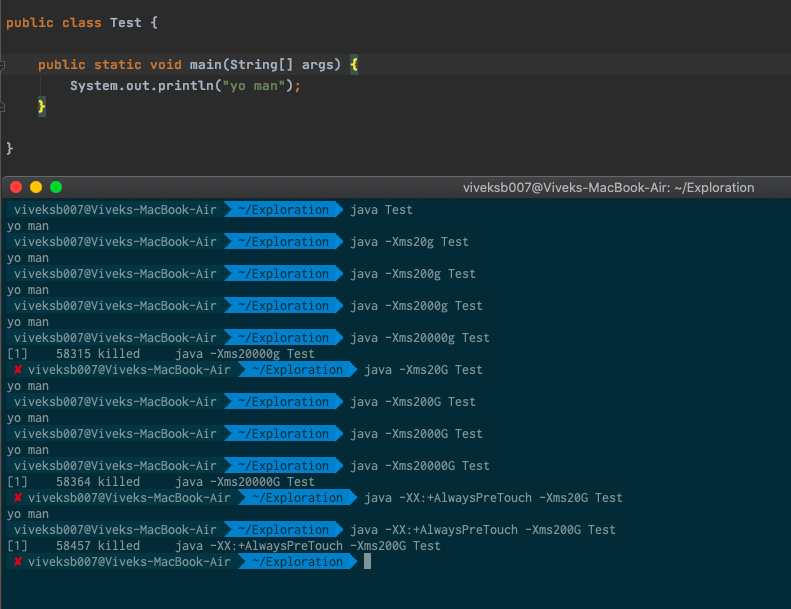In this post, I am going to share my observation after playing with Xms parameter in JVM on different Operating Systems.
Initially, my understanding of Xms was that
Xms is the minimum heap space the JVM should get before starting the Java process, if this much main memory (RAM) isn’t available then program should not start.
So I wrote a simple program which just outputs a String.
// Simple program that I ran with different Xms values
public class Test {
public static void main(String[] args) {
System.out.println("yo man");
}
}
Compiled above program using
javac Test.java
and ran with different Xms values like 20G, 200G, 2000G to see what happens (According to my understanding, any value of Xms more than free RAM should not work). But the result differed when I tried the same thing accross different OS like MacOS and Windows.
java -XmsVALUE Test
Refer below image for the Xms values that I tried and their output after the execution.

Terminal from MAC

Terminal from Windows


Outcome
In MacOS, the program was working fine with Xms values 2000G, (according to my understanding) that would mean that JVM is getting 2000G memory before starting (Thus my understanding is wrong). My Mac has 8GB main memory and 125GB SSD. Tried the same things on Windows, there the program was not running if Xms value more than 10G. Avaiable RAM in my windows system was around ~10G. Total RAM in Windows system is 16G.
Result
Xms behaves differently w.r.t OS, when I ran with Xms value 20G on MacOS, it worked like a charm. But when the same thing was executed on Windows, it gave an error Could not reserve enough space for object heap.
java -Xms20G Test
This means that the JVM wants 20G memory, what happens after this is OS dependent, Windows is reserving the virual memory and mapping that virual memory to the physical memory. In above case, I have 10G free RAM so the program runs, but when I set Xms value to 12G, it doesn’t work because the system doesn’t have 12G physical memory to provide to the JVM. However in case of Mac, it reserves the virtual memory for JVM without mapping it to physical memory.
To map virtual memory to physical memory, I found a JVM param AlwaysPreTouch
From Oracle documentation:
-XX:+AlwaysPreTouch => Pre-touch the Java heap during JVM initialization. Every page of the heap is thus demand-zeroed during initialization rather than incrementally during application execution.
java -XX:+AlwaysPreTouch -Xms20G Test
This works in the same way with a caveat that the JVM touches all the pages in the initialization phase of application. Apparently, this works in Mac, somehow MacOS gives 20GB memory to JVM (See image below). But when I run this with -Xms200G, it stops working in MacOS too. Now the question is how does prefaulting 20G memory in MacOS works. This might give you some idea.

References
- https://stackoverflow.com/questions/43302720/do-the-xms-and-xmx-flags-reserve-the-machines-resources/43307880#43307880
- https://www.oracle.com/java/technologies/javase/vmoptions-jsp.html
P.S
I read Xms memory is limited by RAM + Swap Memory, but in some OS it can exceed that depending upon whether you are prefaulting the memory or not. If some part of post is inaccurate or if there is something I am missing. Please comment, I will be happy to update post.